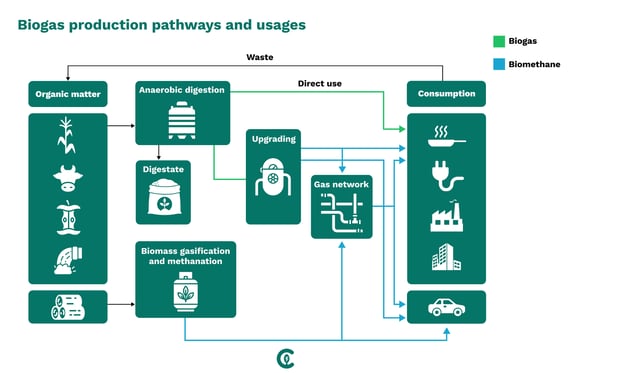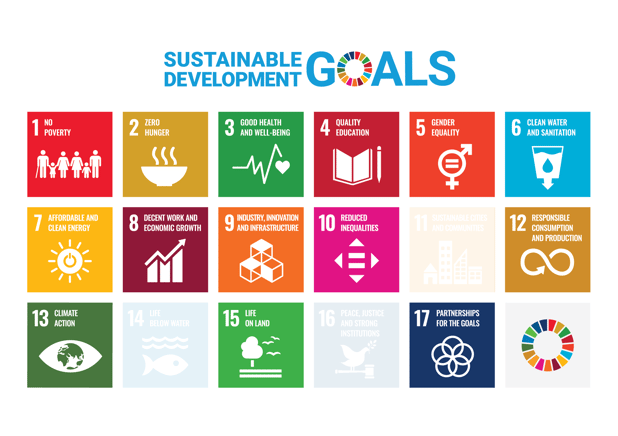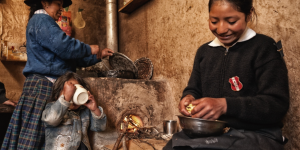What is biogas?
Biogas is a mixture of gases, mostly consisting of methane (CH4), carbon dioxide (CO2), and small quantities of other gases. It is a by-product of anaerobic digestion - the chemical process of bacterial decomposition of organic matter in the absence of oxygen - which produces biogas in return. This occurs naturally in our digestive systems for example, or in the depths of effluent ponds, but it can also be artificially engineered in biodigesters.
What are biodigesters?
Biodigesters are airtight, oxygen-free systems (e.g., container or tank) that provide an optimal environment with the necessary parameters for a controlled anaerobic digestion to produce biogas. Different sources of biowaste can be used as input in biodigesters to produce biogas: agricultural residues, animal manure, forestry residues, municipal solid waste (i.e., food waste, paper, etc.), and municipal wastewater (i.e., sewage biosolids). Today, most biogas production comes from agricultural residues in the form of crops and animal manure.

The potential of biogas
Biogas is a fast-growing form of bioenergy that sits at the intersection of two big challenges of modern life: the increasing amount of waste and the need to mitigate greenhouse gas emissions.
The multiple uses and benefits of biogas, as well as its reuse potential for a circular economy are largely documented. However, the contributions from small-scale digesters in rural areas of developing countries have a stronger, more meaningful value in the fight to mitigate climate change and its collateral effects.
The problem today
At the time of this writing, 3.4 billion people live in rural areas, 90% of whom are in Africa and Asia. Rural populations in developing countries are increasing in size and density at a faster rate than energy supplies, and access to electricity is being made available. This gap leads to an overreliance on traditional biomass such as fuelwood as a cheaper and more accessible primary source of energy to meet the increasing energy demand for electricity, cooking, and heating.
This, combined with the frequent absence of environmental controls and policies in rural areas, results in an increase in deforestation levels and intensification of agricultural land use. Thus, nearby forests and ecosystems pay the price.
Even more, weak waste management infrastructures or lack thereof drive practices that negatively affect the environment, such as burning waste which further pollutes land, water, and air.
The potential for rural communities in developing countries
In areas where the energy supply is unstable, biogas systems present a smart and valuable opportunity roadmap. Small-scale digesters, which can be installed and used in household-level systems, increase universal and independent access to reliable energy generation which in return boosts a range of health, social and economic benefits.
Health
Biogas is a clean cooking fuel alternative that displaces the need for wood or coal-burning cookstoves, improving community health by reducing household air pollution and preventing respiratory illnesses.
Social
Increased access to electricity helps balance gender equality and drive education rates. It uplifts women to pursue other interests and careers by saving hours of firewood collection time that can be invested elsewhere, and increases education rates by allowing students to extend their study time at night.
Economic
Biogas systems improve rural infrastructure for waste management and offer a range of potential revenue streams, increasing job opportunities and boosting economic development in the community. They can produce high-quality, concentrated liquid organic fertilizer for improved land management and increased crop yield, building and maintaining healthy and productive soils needed for sustainable food production.
Ultimately, implementing biogas systems such as biodigesters can help achieve several Sustainable Development Goals (SDGs). Biodigester projects have been found to have direct impacts and contributions to 14 out of the 17 SDGs, with the main contributions coming from their ability to increase affordable and clean energy, reduce climate change, enhance the waste management process, and create jobs.

The role of carbon finance
Construction of household-level biodigesters depends on the type of material availability, climatic conditions, feedstock available, geographical location, policy regulations among others and vary in terms of cost, life span and required level of maintenance. Unsurprisingly, then, the biggest barriers to entry in the mass adoption of biodigesters today are the cost and complexity of development and implementation.
Voluntary carbon markets provide a financing corridor to bridge the technical gap and drive the dissemination of biogas projects otherwise not supported by policy.
At ClimateSeed, we strongly believe in the potential of biogas to help fight climate change and promote sustainable development. We support and work closely with biogas projects around the world, aiming to create a positive impact on both the environment and society.
Join us in our mission to build a better future through sustainable energy solutions.
References:
Anaerobic Digestion: Biogas Production and Odor Reduction. (2023). PennState Extension : https://extension.psu.edu/anaerobic-digestion-biogas-production-and-odor-reduction
International Energy Agency (IEA). (2022) “Outlook for Biogas and Biomethane. Prospects for Organic Growth.” : https://www.iea.org/reports/outlook-for-biogas-and-biomethane-prospects-for-organic-growth
Obaideen, K., Abdelkareem, M. A., Wilberforce, T., Elsaid, K., Sayed, E. T., Maghrabie, H. M., & Olabi, A. G. (2022). Biogas role in achievement of the sustainable development goals: Evaluation, Challenges, and Guidelines. Journal of the Taiwan Institute of Chemical Engineers, 131, 104207–. : https://www.sciencedirect.com/science/article/abs/pii/S1876107022000062?via%3Dihub
Our World in Data. (2022). Urban and rural population: https://ourworldindata.org/grapher/urban-and-rural-population
Common Q&As
Biogas digesters process degradable organic waste, mainly agricultural and food waste. Agricultural waste includes animal manure and slurry (solid and liquid excrement from livestock farms), as well as crop residues such as straw, crop remains, and uneatable fruit. Food waste includes kitchen residues (peelings, meal leftovers) and, in some cases, by-products of the agri-food industry, such as animal fats or manufacturing residues.
At community level, the biogas produced by biodigesters is used as a fuel for cooking, heating or generating electricity, providing households with a cleaner, more sustainable source of energy. Traditional cooking methods, such as burning wood or coal, generate significant indoor pollution due to toxic fumes, and exert significant pressure on surrounding forests. By replacing these fuels, biogas projects reduce CO₂ emissions linked to deforestation and fossil fuel combustion. They thus contribute not only to avoiding emissions, but also to improving the living conditions of beneficiary families.
Presented as a key solution for avoiding greenhouse gas emissions, biogas projects play an essential role in organic waste management and the transition to renewable energies. These projects occupy a unique place in the ClimateSeed catalog, highlighting not only their positive impact on the climate, but also their many social co-benefits. Aware of the potential of biogas, ClimateSeed is collaborating with an innovative program in China, which supports nearly 400,000 low-income rural households in Sichuan province. The program provides state-of-the-art biogas digesters and smokeless biogas stoves, installed and maintained by local technicians, improving living conditions while reducing carbon footprints.
There are several major obstacles to the widespread adoption of biogas digesters. These include the high cost of the initial investment to build the biodigesters, the infrastructure required to deliver the biogas to households, the logistical management of the continuous supply of organic matter, the maintenance of the biodigesters and, last but not least, certain cultural barriers linked to the handling of waste.
One of the key contributions of carbon financing lies in its ability to remove these barriers. Over and above the financial support required for the initial installation and maintenance of digesters, it also facilitates awareness-raising campaigns to educate communities about the advantages of biogas over traditional cooking fuels.
Share this
You May Also Like
These Related Stories

Biogas & Household Communities in the VCM: Reducing Emissions & Empowering Communities

Giving an Access to Clean Cooking in Cookstoves Projects


